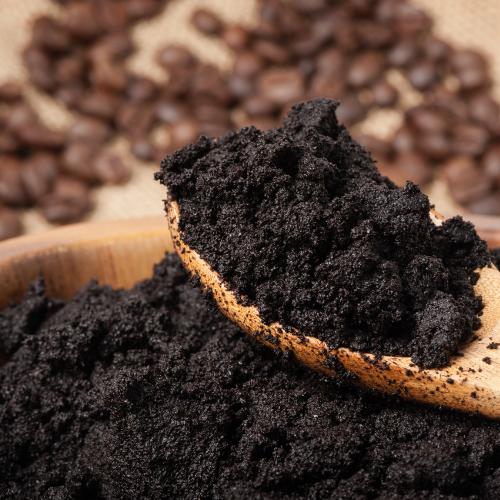
Coffee Grounds in Your Garden: Providing Nutrients, Deterring Pests, and More
You’ve just brewed a truly spectacular cup of coffee.
The aromas are invitingly wafting throughout the room.
Your taste buds awaken as you pour a piping hot mug of pure perfection.
In the moments between brewing and sipping, you gather the used grounds and head over to your kitchen sink. Wait, you can’t pour them down the drain, over time they’ll build up and create clogs.
So, you move to your trash can to dispose of the grounds. Then you begin to ponder, “millions of people drink coffee, if we all dump the grounds in the trash, does this negatively affect the environment while they decompose in landfills across the globe? Surely there’s a better way to dispose of my coffee grounds!”
It is true that disposing of coffee grounds in your kitchen sink can create clogs over time.
And, the oils and other compounds in coffee grounds accumulating in landfills (in obviously outrageous quantities) can generate harmful greenhouse gasses.
So then, aside from adding the grounds to your compost bin, how else can those grounds be used?
There are actually many ways you can reuse your coffee grounds, from spice rubs, to odor eliminators, face scrubs, and more!
Today, we’ll dig down deep, get our hands (or spades) dirty, and focus on the how-to’s as well as the benefits of using those grounds in your garden.

Why do Coffee Grounds Bring Garden Benefits?
Whether you prefer pre-ground Lifeboost coffee or choose to grind those delicious Lifeboost coffee beans yourself, most brewing methods leave you with a tasty cup of joe and a need to dispose of the byproducts of that brewing method, coffee grounds.
Ah, but take a look at the language used there: byproducts…waste, these two terms technically don’t belong together.
You see, byproducts aren’t actually waste but secondary products made from the production of something else.
And, when you produce a tasty cup of coffee, the byproducts, or coffee grounds, boast big benefits to your garden!
But how?
What is it about coffee grounds that brings about such a unique benefit?
First, coffee grounds are rich in nutrients like nitrogen, phosphorus, and potassium.
Nitrogen is a highly abundant element in the air we breathe, but most soils can be deficient in this nutrient.
When you add coffee grounds to dry materials, like soil, potting mixes, or other organic materials such as leaves, the nitrogen in the coffee is more easily released.
Nitrogen aids in a plants ability to use sunshine, optimizing photosynthesis and promoting growth.
Phosphorus helps plants use and store energy, even promoting root growth.
Potassium not only protects plants against disease, but it also increases the overall yield of crops.
The benefits of these nutrients make them top picks for many chemical fertilizers used in gardens. Switching to coffee grounds can negate the use of such chemicals.
Second, there are actually some compounds in coffee grounds that are toxic to weeds, making the use of grounds in your garden a great benefit concerning weed control.
Obviously this means there are some plants you’d want to avoid using the grounds near (we’ll get to that list in a moment), but when it pertains to acceptable plants, you can omit the use of harsh chemicals to deter weed growth simply by incorporating the use of coffee grounds.
Third, adding coffee grounds to soil increases the amount of organic material present which
- improves the soil’s capacity for holding water
- provides natural aeration
- allows for proper drainage
So then, how exactly can you use those leftover grounds in your garden?

Five Ways To Use Coffee Grounds In Your Garden
1- Natural Fertilizer
In the section above we briefly mentioned the fertilizing effects of nitrogen. Since coffee grounds are a rich source of this nutrient, there are a few ways you can use them in your garden.
- You can make a liquid fertilizer by adding 2 cups of used coffee grounds to a five gallon bucket of water. Allow the grounds to steep in the water overnight, then strain. Pour the liquid into the soil to fertilize your garden or potted plants.
- If you notice your plants suffering from nutrient deficiencies, you use this same liquid fertilizer to spray in small amounts directly onto the leaves and stems of plants.
2- Pest Barrier
Some say using coffee grounds won’t repel pests completely, while others insist sprinkling used grounds in the form of a barrier around your plants works wonders at deterring unwanted insects and critters alike.
The texture of used coffee grounds tends to be quite abrasive, and this acts as a deterrent for slugs and snails, keeping them from crawling over a barrier of coffee grounds to reach the plants they desire to consume.
If you’re having trouble with a cat using your garden as a litter box, coffee grounds have been known to deter felines due to their caffeine content.
And, due to the potent scent of coffee, sprinkling used grounds in your garden is said to deter rabbits and other small mammals known for viewing your garden as a veritable smorgasbord.
3- Mulch
Leftover coffee grounds make a great mulch for gardens, as long as you recognize that we’re not recommending saving up several five gallon buckets filled with your coffee brewing remnants.
When using coffee grounds as mulch in your garden, a thick layer could prohibit both water and air from passing through the soil, ultimately hindering your plants.
Instead, spread a half inch layer of used grounds over the soil, then cover with two to four inches of organic matter such as compost or wood bark/chips.
This allows you to use a lesser amount of traditional mulch, while also providing nutrients to the soil in your garden.
4- Acidify Soil
Soils west of the Mississippi River tend to be highly alkaline. Planting a garden in such an area, therefore, may require acidification of the soil.
Always test your soil’s pH first, but if those results prove your soil to be too alkaline, you can add fresh ground coffee to your garden to balance things out.
To do so, simply add the coffee grounds into the soil at a depth of 7 to 8 inches.
5- Weed and Fungal Suppression
As a general rule of thumb, the caffeine content of fresh grounds (not used grounds) can keep weeds and fungal pathogens from growing in your garden.
However, this benefit is tricky as some plants can be negatively affected by the caffeine in coffee.
Which leads us to our next thought - which plants benefit from the use of coffee grounds?

Plant Likes and Dislikes - The Do’s and Don’ts of Gardening with Coffee Grounds
Most soils benefit from the nutrient content of coffee.
But, some plants are sensitive to the acidic nature of some coffees as well as the caffeine content (even in leftover grounds).
So, here are a few do’s and don’ts as well as some specific plants to pay special attention to when gardening with coffee grounds.
Do’s
Do use a clean coffee.
If you’re drinking a coffee that’s grown with the use of harsh chemicals like pesticides and fertilizers, or one that contains molds and other toxins, not only is this bad for your health, but if you’re reusing the leftover grounds in your garden, this will be bad for the health of your plants as well.
Do use a nutrient-rich coffee.
Coffees that are grown in the shade, sustainably, and at high elevations typically contain a greater amount of nutrients as these conditions necessitate a longer growth time for the coffee cherries to mature, meaning the plants soak up more nutrients from the soil.
This translates to a greater amount of nutrients for you as you sip and for your garden soil with the use of the grounds.
Do use leftover grounds in potted plants as well! And, if you still have leftover grounds, consider adding them to your compost bin.
Do experiment with the amount of grounds you use and the ways in which you use them.
This one here deserves some bold lettering as many folks can attest to the benefits of perseverance when faced with a bit of difficulty using coffee grounds in their gardens.
Some folks even prefer composting their grounds first, then applying to the garden for best success.
Do use flavored grounds as well. According to our findings, using leftover coffee grounds from clean flavored selections (such as Lifeboost) works just as well as unflavored selections.
Don’ts
Don’t spread unused coffee grounds (fresh) in your garden if you have outdoor dogs that like to eat or lick whatever they find. The caffeine content can be harmful to your furry friends.
The same is true of cats, though most cats are known to avoid coffee grounds, making it a safe deterrent for felines.
Don’t fall into the “a little is good, so more must be better” trap.
You absolutely can overdo it when it comes to using coffee grounds in your garden. So, be sure to follow the guidelines throughout the article to ensure you’re not going overboard.
Don’t use fresh coffee grounds on seedlings or young plants as this can stunt their growth. Save the grounds for use after the plants have had a bit of time to grow.

Likes
Most plants can benefit from using leftover coffee grounds in the soil where they’re grown. But, some plants really thrive in the presence of these grounds, namely:
- Hydrangeas
- Rhododendrons
- Azaleas
- Lily of the Valley
- Holly
- Berries
- Carrots
- Radishes
- Cabbage
- Sweet potatoes
- Broccoli
- Peppers
- Legumes (when composted grounds are used)
Dislikes
Unfortunately, some plants just aren’t coffee lovers like you and I. Therefore, you’ll want to avoid using fresh or leftover grounds on the following plants:
- Roses
- Trilliums
- Daffodils
- Japanese Irises
- Geraniums
- Ferns
- Chinese mustard
- Italian ryegrass
- Clover
- Alfalfa
- Tomatoes (some people have had success using leftover decaffeinated coffee grounds when growing tomatoes)
Final Thoughts
Coffee grounds are a perfect way to turn waste into a byproduct - something we can repurpose and reap the benefits of in our gardens!
So, after you finish that cup of brewed perfection, make sure to save your grounds and give a nutrient boost to your plants and vegetables.
- https://www.mrrooter.com/about/blog/2019/november/can-you-put-coffee-grounds-down-the-sink-/
- https://perfectdailygrind.com/2020/09/what-happens-to-coffee-grounds-after-theyre-used/#
- https://www.epa.gov/nutrientpollution/issue#
- https://plantscience.psu.edu/research/labs/roots/methods/methods-info/nutritional-disorders-displayed/nitrogen-deficiency
- https://kochagronomicservices.com/knowledge-center/The-Role-of-Nitrogen-in-Crop-Production-and-How-to-Protect-It_2288.aspx#
- https://agriculture.vic.gov.au/climate-and-weather/understanding-carbon-and-emissions/nitrogen-fertilisers-improving-efficiency-and-saving-money
- https://www.countryliving.com/uk/homes-interiors/gardens/a36070165/coffee-grounds-garden/#
- https://www.thespruce.com/using-coffee-grounds-in-your-garden-2539864#
- https://oxfordgardendesign.co.uk/are-coffee-grounds-good-for-your-garden/
- https://www.tfi.org/the-feed/fertilizer-101-big-3-nitrogen-phosphorus-and-potassium#
- https://www.sunset.com/garden/earth-friendly/starbucks-coffee-compost-test#
- https://www.liquidfence.com/safeguard-your-garden.aspx#:~:text
- https://www.hgtv.com/outdoors/gardens/planting-and-maintenance/how-to-use-coffee-grounds-in-the-garden
- https://www.hgtv.com/outdoors/gardens/planting-and-maintenance/how-to-use-coffee-grounds-in-the-garden
- https://www.growertoday.com/list-of-vegetables-that-like-coffee-grounds/
- https://coffeeaffection.com/what-plants-like-coffee-grounds/
- References for the article to confirm data and information.
Drop a Comment
Yes they are wonderful for Tomato plants!
Yes, John and I are using coffee grounds in my garden for the past 47yrs. They are the best to help any garden.
I believe that used coffee grounds are beneficial for growing tomatoe plants!










